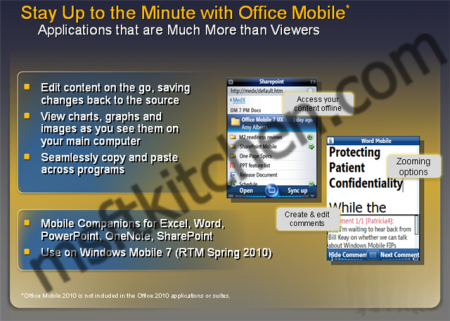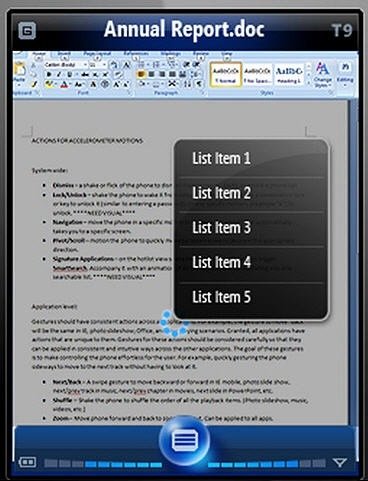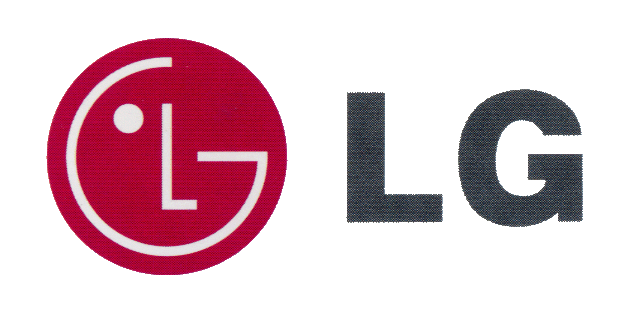Windows Mobile 7: What we expect and what we are hearing

Okay everyone, time to put on your rumor helmets (they're like beer helmets, but filled with vodka). Here's what we are hearing about Windows Mobile 7 from various sources (none of which has been announced by Microsoft).
We'll spill the beans on what we're hearing about supposed various versions of Seven, two WM7 devices including full specs (the LG "Apollo" and HTC "Obsession") time-frames and even features.
There's a lot below, and we need to start with a disclaimer. What follows are details and speculation from anonymous sources. Some of the details have been corroborated by other sources, but even that doesn't mean they'll end up being true. Other parts have to be taken with a grain of salt, as they seem to be too good to be true, and they may well be. So keep that in mind as you read this piece. Fact is until Microsoft or its partners announce anything, nothing is for certain.
Also note that none of the images below are "new," but rather are recycled images from earlier stories that relate to or corroborate the accompanying information.
Now onto the goods ...
Software
Nomenclature
First, it's not Windows Mobile 7 but just "Seven," so that's how we're going to refer to the OS from now on. Also the phrase "Microsoft Zune Phone Experience" may be tossed around.
Second, we are hearing there will be two versions: Business edition and Media edition — those aren't necessarily the names we'll see them launch with, just different branches of development. We believe this partially explains some of the seemingly contradictory rumors about release dates, as they are not on the same release track.
All the latest news, reviews, and guides for Windows and Xbox diehards.
Windows phone Seven Business edition (BE)

The business edition is the version that is nearest in completion, but one we might not see bare naked. It's a more stripped down version of Seven and while it can still do media, it has less thrill than the Media edition (see below).
This is also the version that most likely will see OEM overlays on top of, like HTC's Sense UI.
This version will also feature the ability to sync "to the cloud" with multiple devices, including your home PC. This won't be so much as syncing though as live manipulation of data — meaning you can work on and edit a Word document stored on your PC or work computer remotely. It reportedly also will allow multiple user access, meaning two or three people can all view and edit the same document dynamically, from different computers, including your Windows phone. You can even take a photo on your phone and embed it to the document directly.

For most consumers, that's no big deal. But for business users, it promises to be amazing. In fact, Office in general is suppose to be an entirely new, extremely impressive experience — which is actually something we would expect.
Why a more stripped down version of Windows Mobile? Simple.
- It allows OEMs more flexibility on customization.
- It makes the device less resource-intensive, saving processing power, RAM and battery for cloud services and business applications.
The HTC HD2 reportedly is able to run this version currently and it is slated for a possible October/November upgrade. Also, the HD2 reportedly runs Seven with "minimal lag" at this very early stage of porting.
Minimum resolution for programs on Seven is 800 pixels by 480 pixels (WVGA), which if accurate puts today's top-of-the-line Windows phone at the bottom of tomorrow's specs. Unfortunately, without actual images, describing the OS seems to be a bit of a challenge. The closest we've heard is
Think TouchFLO (slider tabs) meeting up with a stock SPB Shell (lots of information on multiple screen) mixed with a very well integrated message and app launcher — almost a 'fun' BlackBerry interface. Seems like the stock shell is more like a really good BB theme than iPhone or Android.
Windows phone Seven Media edition (ME)

This
is the big kahuna. The one that Microsoft is really banking on. The one that is not yet nearly as complete, and, yes, if there was one we probably won't have in our hands till 2011, it's this version.
It's also likely the version we'll see snippets of in Barcelona next month at Mobile World Congress.
Expect portions of this version to be demoed on either a hitherto unseen seen LG or HTC device (more on that below).
What portions of the OS will be shown off at Mobile World Congress? We're hearing HD video, a Zune-like music player, and possibly streaming TV. Also, bits of the control panel and other aspects of the UI may be shown. Because it is not complete, we won't see the whole OS in action.
It will be a tease, for sure.
The plan for this version on release is to have support for
- Silverlight
- Mediaroom
- XBox Live (possibly gameplay)
- Facebook and Twtter interfaces (similar to Xbox)
- Zune Music integration
Early reports mention syncing Twitter and Facebook right on your home screen (hardly a new invention) and that Xbox integration is well under way, looking "awesome."
We're also hearing the Media Edition is still very dynamic at this point, with more features being added. Microsoft is really trying with this one to deliver everything we expect and demand.
While this isn't a "Zune phone" per se, it will very much echo that design and experience.
Windows Sensor and Location Platform: 'Orion'
We learned about this long time ago and haven't heard much since. But while we're dishing everything we've heard ...
"Orion" is a cloud-based assisted GPS system that is supposed to dramatically increase initial location-lock performance. This will guarantee rapid GPS performance across all future Seven devices, regardless of carrier support (currently, aGPS is dependent on individual carrier implementation).
The radio-interface layer (RIL) is being updated to support multiple-tower signal detection and trilateration (think Google's My Location service in Google Maps) and IP resolving. In addition, information garnered from WiFi connections will also be used for faster location detection (also similar to Google Maps). All of this information is then passed on up via API to third-party software for ease of access and limited instruction sets.
Planned performance for an initial lock (cold start) is targeted at less than 1 second and would find you within 300 meters. A hot or warm start is targeted at less than 0.25 seconds and would track you at less than 10 meters.
What actually happens with this location-information in terms of end-user services is currently not known — that is we do not know how the OS will utilize it for the the end-user experience. See the video from Channel 9 for some hints.
Interesting tidbit: Orion already is a part of Windows 7 (desktop OS), part of the Windows Sensor and Location Platform initiative. We think this is pretty good evidence of the merging of Windows desktop and Mobile platforms, or perhaps overlap is more apt.
See "What is Orion Sensor device that shows up on Windows 7 PC?" and a video discussion for the big picture from Microsoft's API developers on Channel 9.
Hardware
What would this article be without some information regarding what Seven hardware may look like? Below are two devices that reportedly are launching this year and will be the model Seven phones. Again, none of this is official or has been announced by Microsoft or any of its partners. It might not happen, and you know how it goes with device dates; later is more likely than sooner. This is just what we've been told.
LG 'Apollo'

The first Seven device that is expected to launch is the LG "Apollo." While we cannot confirm the existence of this device with actual pictures (yet), we do have the supposed specifications. If it is to be believed, then this is truly drool-worthy.
To us, it sounds like something in the same class as the just announced LG GW990.
Make no mistake about LG — it is a big player with Microsoft, having a team in Redmond working with it directly, releasing the first Snapdragon/pico projector/finger print scanner device in the U.S (eXpo) — LG is playing for keeps.
- Launching: August/September 2010
- CPU: Qualcomm QSD8650; 1.3GHz
- CDMA + GSM (aka a World Phone)
- EvDO + HSDPA
- Device Size: 115 x 57.5 x 11.2 mm
- Memory (RAM/ROM): 1GB/1GB
- External Storage: MicroSD (up to 32GB)
- Screen Size/Type: 3.8-inch capacitive AMOLED “Multitouch Supported”
- Screen Resolution: WXGA 1280 x 720 px
- Camera: 10-megapixel with flash and autofocus; HD 720p video@ 30fps
- Video Support: Windows Media Video (WMV), MPEG-4 (MP4/M4V) H.264, DVR-MS4
- Audio Support: Windows Media Audio (WMA), Advanced Audio Coding (AAC-LC), FairPlay DRM, MP3
- Battery: Removable 1400 mAh
- Talk Time: Up to 7.5 hours
- Standby Time: 288 hours
- Internet Use: 4.5 hours (3G), 6.5 hours (WiFi)
- Video Playback: 10 hours
- Audio Playback: 30 hours
We do question the Qualcomm QSD8650; 1.3GHz number, only because we know that chip can do 1GHz, but not 1.3GHz. Qualcomm did recently announce a 1.3GHz Snapdragon, but it is the 8X50A, not QSD8650.
Ah, but maybe they forgot the "a"? See, there is a QSD8650A that does run at 1.3GHz.
However, there are other potential red flags: screen and camera resolution.
While we would seriously love to have 1280x720 on a 3.8-inch screen, that almost seems out of bounds (and largely unnecessary) for today's technology. We understand that there is 720P video recording out there today, but we have never heard of Samsung or anyone hitting WXGA resolutions on an AMOLED screen yet at that size.
Likewise, the 10MP camera also is on the high end. Of course anything is possible, and LG seems to be serious with competing against the likes of HTC, but even we are a bit skeptical. More likely is that we're looking at the maximum specs the processor will allow.
Devil's advocate: The Qualcomm QSD8650a does support WXGA resolution, and there is a 5-inch WXGA device on the market (see MyRacer Lisse T10 PMP).
A supposed hands-on report with the LG "Apollo" claims that this screen "blows away the HD2." It is a silver, metallic slab device and is quite light.
The chipset is a CDMA/GSM hybrid and yes, reportedly Sprint and Verizon will be carrying it. Reportedly. We'll just have to see.
Is LG really sitting on such a monster of a device? One would expect that the first Windows Seven phone to be a stunner, and this sure seems to fit the bill. Time will tell.
HTC 'Obsession'

(Note: the above is just an unrelated rendering, not the "Obsession")
This is the device we have a better chance at seeing at Mobile World Congress, as the LG device is still going through some development pains. Think of the Obsession as a slightly smaller HD2.
And yes, HTC is working with Microsoft on Sense UI integration for Seven, we hear there is no tension between them on this feature.
- Launching: October 2010
- CPU: Qualcomm QSD8250; 1GHz
- GSM HSDPA
- Device Size: 112 x 56 x 11.7 mm
- Memory (RAM/ROM): 512MB/512MB
- Internal Storage: 4GB
- External Storage: MicroSD (up to 32GB)
- Screen Size/Type: 3.7-inch capacitive AMOLED “Multitouch Supported”
- Camera: 5.0 Megapixel AF with flash; HD 720p video@ 25fps
- Video Support: Windows Media Video (WMV), MPEG-4 (MP4/M4V) H.264, DVR-MS4
- Audio Support: Windows Media Audio (WMA), Advanced Audio Coding (AAC-LC), FairPlay DRM, MP3 (.mp3)
- Battery: Removable 1230 mAh
- Talk Time: Up to 10 hours
- Standby Time: 240 hours
- Internet Use: 6 hours (3G), 7.5 hours (WiFi)
- Video Playback: 7 hours
- Audio Playback: 24 hours
The "Obsession" reportedly looks like the Verizon Imagio, which if true makes it a good choice.
Look for none other than T-Mobile to be getting this one, followed by other GSM carriers later on.
Conclusion/Analysis
So what to make of the above? We think a lot of this sounds legit and makes sense. Then again, just because things make sense doesn't make them completely accurate. And, again, this is all highly unofficial and unannounced. Things likely will change somewhat.
Like you, we don't have the benefit of actually seeing any of this with our own eyes. Still, when you stand back and look at all the information it starts to come together.
For one, we have seen quite a few "leaked" shots of Seven in the past and while very formal and business looking, they are not full of eye-candy. Yet, we keep hearing about Project Pink, radical overhauls, media- and consumer-centric branches, etc.
Together, all of that doesn't add up, if you're expecting Seven to be just a single operating system. But split it into two branches, and it does make sense: Microsoft has one conservative version, built for professionals and that allows OEMs to customize. The other is the "Microsoft Experience" device, the Zune-phone if you will.
It also helps explain the seemingly contradictory release dates — some parts of the OS are more ready than others.
Still, with only a few weeks left until Mobile World Congress in Barcelona, we think we'll know soon enough how much of this is true or not as we (and others) are convinced that Microsoft will reveal something about Seven during that event.
Finally, we are expecting more information to come forth in the coming weeks, so keep checking back for updates.
[Thanks 'Z' and Anonymous]

Daniel Rubino is the Editor-in-chief of Windows Central. He is also the head reviewer, podcast co-host, and analyst. He has been covering Microsoft since 2007 when this site was called WMExperts (and later Windows Phone Central). His interests include Windows, laptops, next-gen computing, and wearable tech. He has reviewed laptops for over 10 years and is particularly fond of 2-in-1 convertibles, Arm64 processors, new form factors, and thin-and-light PCs. Before all this tech stuff, he worked on a Ph.D. in linguistics, performed polysomnographs in NYC, and was a motion-picture operator for 17 years.
